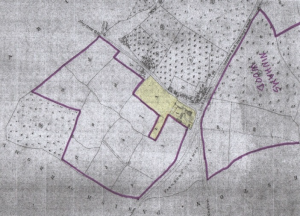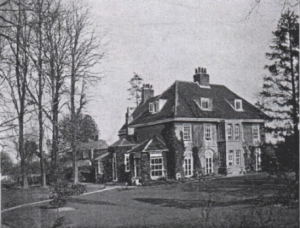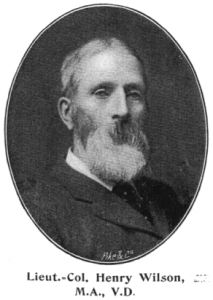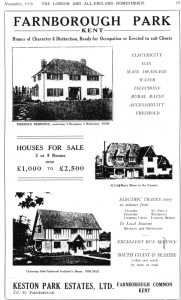Progress and Vision
Farnborough Park saw its origin in 1926, the realisation of a visionary project by developers Frederick Rogers and his son Eric Rogers. Frederick had returned from a trip to America, where he had much admired the openness of certain residential estates (steeped in trees and gardens with little interruption by walls and fences) and looked for land to reproduce the same residential concept here.

One of the estates that came up for sale was Chalk Farm, then owned by the descendants of titled landowner Robert Harrison and industrialist Thomas Wilson. The history of the Harrisons and the Wilsons, joined together by matrimony, represents a fascinating snapshot of how England was evolving at the turn of the 18th century. It is as if the changing social landscape is personified in these two families, the Harrisons titled and landowners and the Wilsons emerging through enterprise, industry and the rise of the middle class.
Chalk Place

Now called Farnborough Lodge, located at the Elm Walk entrance, the first property on the Chalk Farm Estate is mentioned in 1798 in the History of Bromley as a “rural elegant little mansion” set in grounds of 100 acres. It appears that the Rogers’ vision of merging architecture into nature was already practised in Farnborough Lodge at least. The author of the History of Bromley makes reference to the beautiful gardens, the greenhouse full of “curious exotics”, a well cultivated melon ground and describes it as “one of the happiest combinations of art and nature that can be imagined”.

In 1800 the house was let to Sir General and (later) Baronet John Floyd, the father of Julia, a renowned beauty, who went on to marry Sir Robert Peel, Home Secretary and twice Prime Minister. As Home Secretary, he promoted a bill (passed in 1829) creating the Metropolitan Police, uniformed and patrolling the streets of London – from his name, police officers were nick-named ‘Peelers’. The Floyds however only stayed some 5 years because an epidemic of scarlet fever attacked the entire family and a number of servants. General Floyd’s youngest child and his wife died and the family moved out when General Floyd remarried in 1805.

The house and land passed from the Harrisons to the Wilsons in 1803, at the death of Robert Harrison, via Elizabeth Wilson (nee Harrison). Robert Harrison is buried St. Giles’ Churchyard in Farnborough Village with his great-grand-niece Lucy Wilson, who was the unmarried sister of Henry Wilson, the last owner and inhabitant of Chalk Farm, later renamed Farnborough Lodge Estate (now Farnborough Park) before it was sold to the Rogers in 1925. Henry Wilson was an active member of the Keston Village community and is buried in the Keston parish churchyard.
1926 – A New Beginning

Frederick and his son Eric Rogers had recently acquired land from the Duke of Derby and begun the creation of what is now Keston Park, when the land where Farnborough Park now stands also became available. The origin of the two Parks is therefore inextricable.
The Tudor- style parade of shops in Locksbottom, serving both Parks, was begun by Mr Howard Rogers in 1927 and the building that now hosts the Chapter One restaurant was built to provide refreshments for the new influx of visitors to the properties being built in the two Parks. They were advertised as “Homes of Characters” offering electricity, gas, drainage and water. Transport connections to London by “electric trains every 10 minutes” and buses were also advertised, together with the seaside being within easy reach by train or road. The price of houses varied from £1,000 to £2,500 and plots were for sale for around £250.
By the early 1930s there were already the Westminster Bank (as it was then called), a wine shop, a chemist, a greengrocer, a fish shop and a draper. The war stopped development but there was already a community of residents in Farnborough Park , with a Home Guard and home shelters when the vicinity of Biggin Hill Airport made the area a target for German bombers. The house at the end of the Glen called The Glade was requisitioned by the war department as the headquarters for the Home Guard. There is a report by a then resident of the first whistling bomb having fallen in the garden (fortunately) of Robin Hill in Wood Way and of a resident trying to shoot down a low-flying enemy plane. The same resident reports: “The greatest sort of annoyance at the time were the doodle bugs – six at a time with about twenty minutes’ intervals between them when one could safely get a meal or have a bath. There was, too, something uncanny about them flying without a pilot with a horrible whistling noise, then sudden silence when you knew the bomb was going to fall. We would watch from the front door until the engine stopped and dive under the shelter if we judged it to near for comfort”.
After the war, development in and around the Park continued and was considered completed by 1961. The last property to be sold was the Boundary Lodge at the entrance of Park Avenue from Hastings Road, which had been the architect’s base and estate office. Frederick and Eric Rogers established a set of covenants in each deed of sale so as to preserve the character of the Park. Those covenants still exist and most are still enforceable today.

